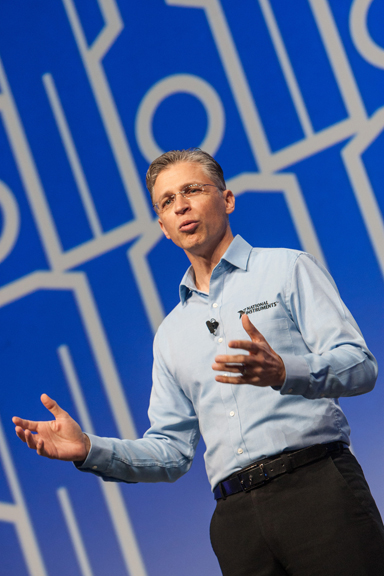
Dave Wilson, NI’s academic marketing director, delivering a keynote at NIWeek 2015.
September 23, 2015
 Dave Wilson, NI’s academic marketing director, delivering a keynote at NIWeek 2015.
Dave Wilson, NI’s academic marketing director, delivering a keynote at NIWeek 2015.On Thursday August 6, Autodesk‘s VP of corporate strategy Jon Pittman, National Instruments’ (NI) academic programs director David Wilson, and UC Berkeley’s mechanical engineering professor emeritus David Auslander joined hands onstage during a keynote address at NIWeek, NI’s annual user conference. Their handshake represents Autodesk, NI, and UC Berkeley’s shared interest to improve the tool chain linking mechanical modeling and system simulation.
The aim of the collaborative partnership, according to NI’s Wilson, is to make it possible to “take the output of Autodesk Inventor, put it together with Modelica [an object-oriented system modeling language], and feed it into the simulation and control design module in [NI’s] LabVIEW.”
Usually, 3D mechanical assembly modeling and system modeling occur in separate silos. The former occurs in 3D MCAD programs like Autodesk Inventor, SolidWorks, and Solid Edge. The latter is considered the domain of system modelers like LabVIEW. But the growing use of software-driven functions and embedded systems—a phenomenon of the IoT era—pushes the two disciplines closer. (For more on this trend, read “CAD vs. System Modeling,” July 2015.)
Lance Grow, Autodesk’s director of Inventor product line, said, “Control design and mechanical engineering are becoming much more interconnected. We don’t believe there’s a good multidisciplinary solution in the market today, and we think it’ll become crucial to the development of connected products.”
UC Berkeley’s Auslander explained, “In mechanical systems, the mathematics can be very messy. They’re full of constraints and non-linearity, and can lead to complex algebraic equations that are difficult to handle—especially in robotics or in products that involve mechanical friction.” Prevented by this daunting task, many who could benefit from simulation may have chosen to skip the step altogether.
Auslander pointed out that, “Engineers could have designed the control system at the same time if they had taken the time to do dynamic simulation. And once the physical system has been built, it’s very costly and time-consuming to refine or modify it.”
A roundtrip workflow between Autodesk Inventor and NI LabVIEW will go along way to connect mechanical system design to dynamic system simulation and control system design. Auslander and his research team are using OpenModelica, an Open Source simulation environment based on Modelica, to facilitate the connection. Commercial version DYMOLA, also based on Modelica, is widely used in automotive. NI’s myRIO and CompactRIO hardware will be part of the workflow for control system design and simulation.
The goal of the project and partnership, according to Auslander, is “an integrated tool chain to make the process of control system design simpler.”
Autodesk’s Grow hinted that NI might join Autodesk representatives at the upcoming Autodesk University conference to further publicize the partnership.
Subscribe to our FREE magazine, FREE email newsletters or both!
About the Author
Kenneth Wong is Digital Engineering’s resident blogger and senior editor. Email him at [email protected] or share your thoughts on this article at digitaleng.news/facebook.
Follow DE





